A solar equinox is a moment in time when the Sun crosses the Earth's equator, which is to say, appears directly above the equator, rather than north or south of the equator. On the day of the equinox, the Sun appears to rise "due east" and set "due west". This occurs twice each year, around 20 March and 23 September.
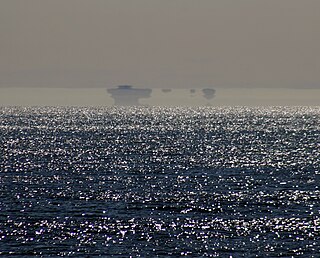
In telecommunications, an atmospheric duct is a horizontal layer in the lower atmosphere in which the vertical refractive index gradients are such that radio signals are guided or ducted, tend to follow the curvature of the Earth, and experience less attenuation in the ducts than they would if the ducts were not present. The duct acts as an atmospheric dielectric waveguide and limits the spread of the wavefront to only the horizontal dimension.

The green flash and green ray are meteorological optical phenomena that sometimes occur transiently around the moment of sunset or sunrise. When the conditions are right, a distinct green spot is briefly visible above the upper rim of the Sun's disk; the green appearance usually lasts for no more than two seconds. Rarely, the green flash can resemble a green ray shooting up from the sunset or sunrise point.

In meteorology, an inversion is a deviation from the normal change of an atmospheric property with altitude. It almost always refers to an inversion of the air temperature lapse rate, in which case it is called a temperature inversion. Normally, air temperature decreases with an increase in altitude, but during an inversion warmer air is held above cooler air.

A mirage is a naturally-occurring optical phenomenon in which light rays bend via refraction to produce a displaced image of distant objects or the sky. The word comes to English via the French (se) mirer, from the Latin mirari, meaning "to look at, to wonder at".

Willem Barentsz, anglicized as William Barents or Barentz, was a Dutch navigator, cartographer, and Arctic explorer.
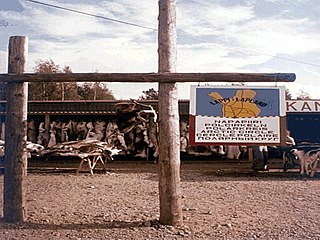
A polar circle is a geographic term for a conditional circular line (arc) referring either to the Arctic Circle or the Antarctic Circle. These are two of the keynote circles of latitude (parallels). On Earth, the Arctic Circle is currently drifting northwards at a speed of about 14.5 m per year and is now at a mean latitude of 66°33′49.2″ N; the Antarctic Circle is currently drifting southwards at a speed of about 14.5 m per year and is now at a mean latitude of 66°33′49.2″ S. Polar circles are often equated with polar regions of Earth. Due to their inherent climate environment, the bulk of the Arctic Circle, much of which is sea, is sparsely settled whereas this applies to all of Antarctica which is mainly land and sheltered ice shelves.
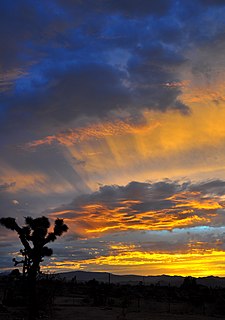
Sunset, also known as sundown, is the daily disappearance of the Sun below the horizon due to Earth's rotation. As viewed from everywhere on Earth, the equinox Sun sets due west at the moment of both the Spring and Autumn equinox. As viewed from the Northern Hemisphere, the sun sets to the northwest in the Northern hemisphere's spring and summer, and to the southwest in the autumn and winter; these seasons are reversed for the Southern Hemisphere.

The midnight sun is a natural phenomenon that occurs in the summer months in places north of the Arctic Circle or south of the Antarctic Circle, when the Sun remains visible at the local midnight. When the midnight sun is seen in the Arctic, the Sun appears to move from left to right, but in Antarctica the equivalent apparent motion is from right to left. This occurs at latitudes from 65°44' to 90° north or south, and does not stop exactly at the Arctic Circle or the Antarctic Circle, due to refraction.
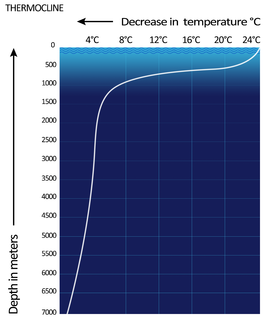
A thermocline is a thin but distinct layer in a large body of fluid in which temperature changes more drastically with depth than it does in the layers above or below. In the ocean, the thermocline divides the upper mixed layer from the calm deep water below.

Atmospheric refraction is the deviation of light or other electromagnetic wave from a straight line as it passes through the atmosphere due to the variation in air density as a function of height. This refraction is due to the velocity of light through air decreasing with increased density. Atmospheric refraction near the ground produces mirages. Such refraction can also raise or lower, or stretch or shorten, the images of distant objects without involving mirages. Turbulent air can make distant objects appear to twinkle or shimmer. The term also applies to the refraction of sound. Atmospheric refraction is considered in measuring the position of both celestial and terrestrial objects.

A Fata Morgana is a complex form of superior mirage visible in a narrow band right above the horizon. The Italian term Fata Morgana translates the name of the Arthurian sorceress Morgan le Fay, due to a belief that these mirages, often seen in the Strait of Messina, were fairy castles in the air or false land conjured up by her witchcraft to lure sailors to their deaths.

Gerrit de Veer was a Dutch officer on Willem Barentsz' second and third voyages of 1595 and 1596 respectively, in search of the Northeast passage.

A false sunrise is any of several atmospheric optical phenomena in which the Sun appears to have risen, but is actually still some distance below the horizon. A number of different atmospheric conditions can be responsible for this effect, all of which divert the sunlight in such a way as to allow it to reach the observer's eye, thereby giving the impression that the light comes directly from the Sun itself. The spread of light can sometimes be deceivingly similar to a true sun.

A mirage of an astronomical object is a meteorological optical phenomenon, in which light rays are bent to produce distorted or multiple images of an astronomical object. The mirages might be observed for such celestial objects as the Sun, the Moon, the planets, bright stars, and very bright comets. The most commonly observed of these are sunset and sunrise mirages.
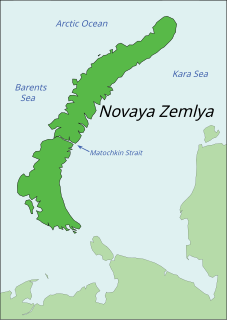
Novaya Zemlya is an archipelago in the northern part of Russia. It is situated in the Arctic Ocean, in the extreme northeast of Europe. It houses the easternmost point of Europe: Cape Flissingsky on the Northern island. To Novaya Zemlya's west lies the Barents Sea and to the east is the Kara Sea.

While mirages are the best known atmospheric refraction phenomena, looming and similar refraction phenomena do not produce mirages. Mirages show an extra image or images of the miraged object, while looming, towering, stooping, and sinking do not. No inverted image is present in those phenomena either. Depending on atmospheric conditions, the objects can appear to be elevated or lowered, stretched or stooped. These phenomena can occur together, changing the appearance of different parts of the objects in different ways. Sometimes these phenomena can occur together with a true mirage.
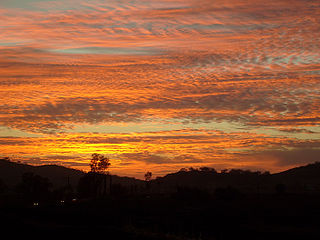
Atmospheric optics is "the study of the optical characteristics of the atmosphere or products of atmospheric processes .... [including] temporal and spatial resolutions beyond those discernible with the naked eye". Meteorological optics is "that part of atmospheric optics concerned with the study of patterns observable with the naked eye". Nevertheless, the two terms are sometimes used interchangeably.
A false sunset can refer to one of two related atmospheric optical phenomena, in which either (1) the Sun appears to be setting into or to have set below the horizon while it is actually still some height above the horizon, or (2) the Sun has already set below the horizon, but still appears to be on or above the horizon. Depending on circumstances, these phenomena can give the impression of an actual sunset.
Nova Zembla is a 2011 Dutch historical drama film directed by Reinout Oerlemans. It is the first Dutch feature film in 3D.

















